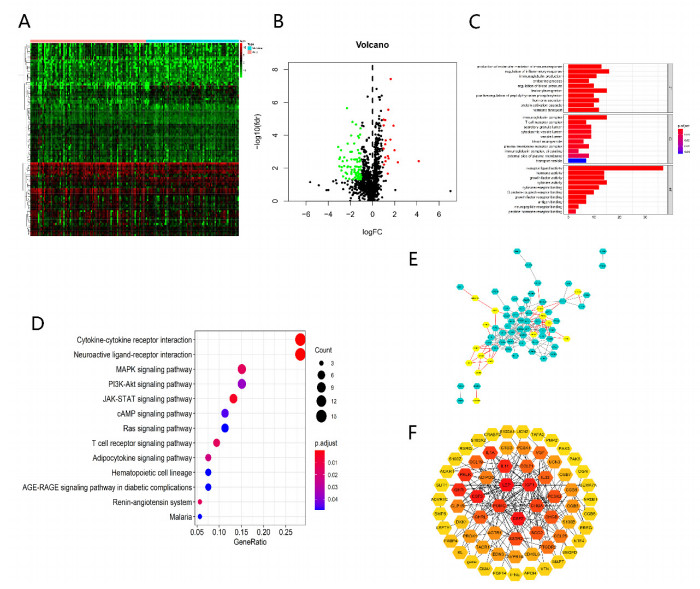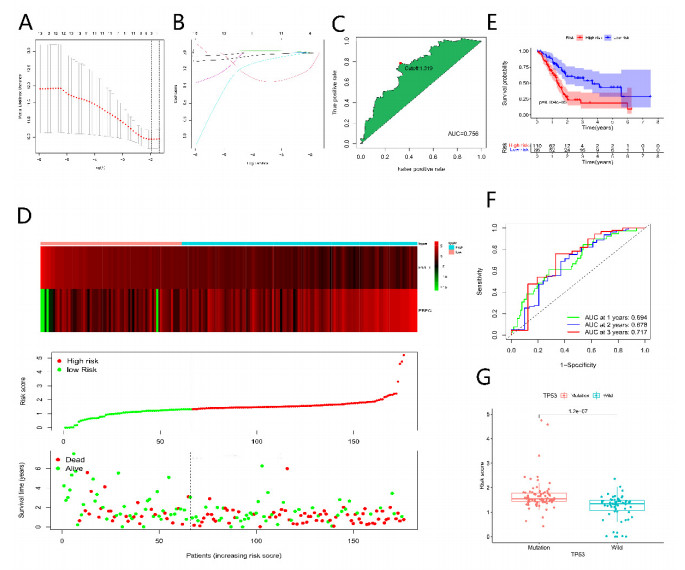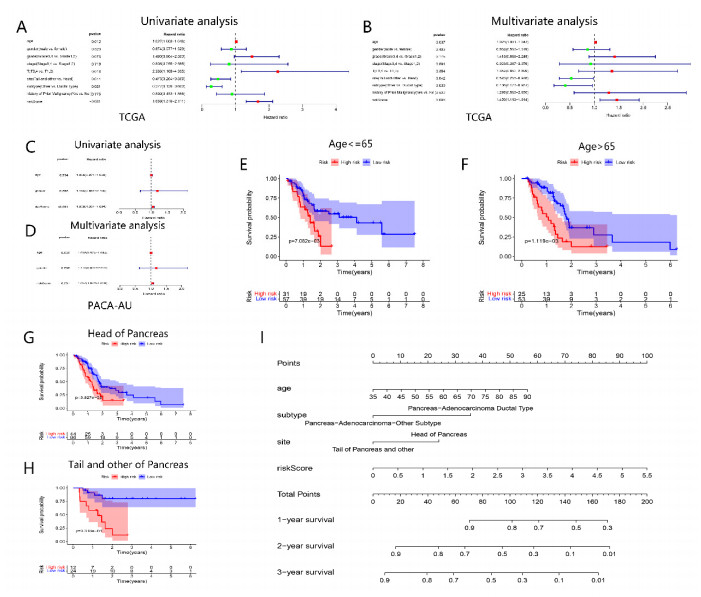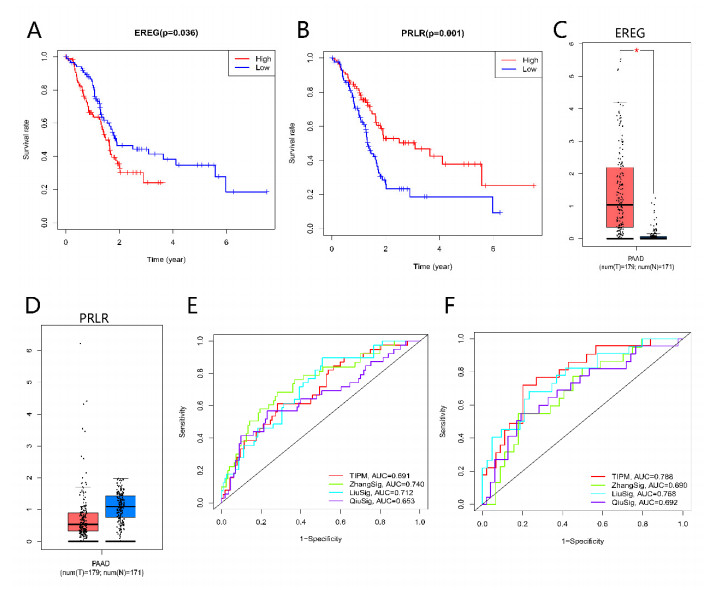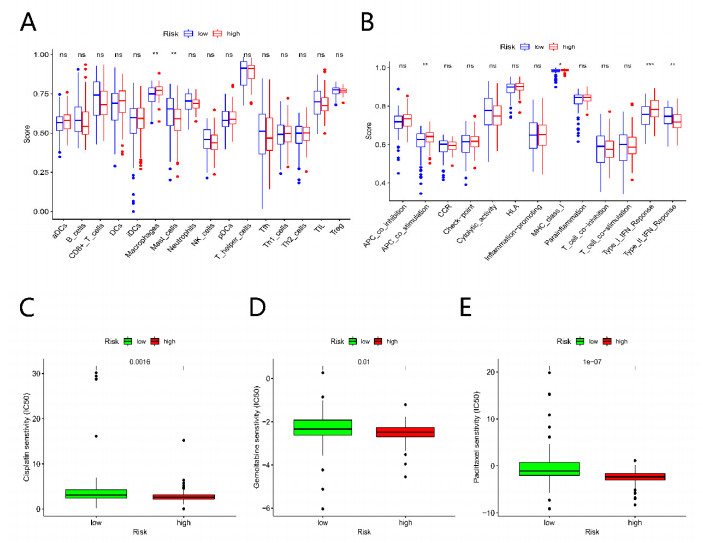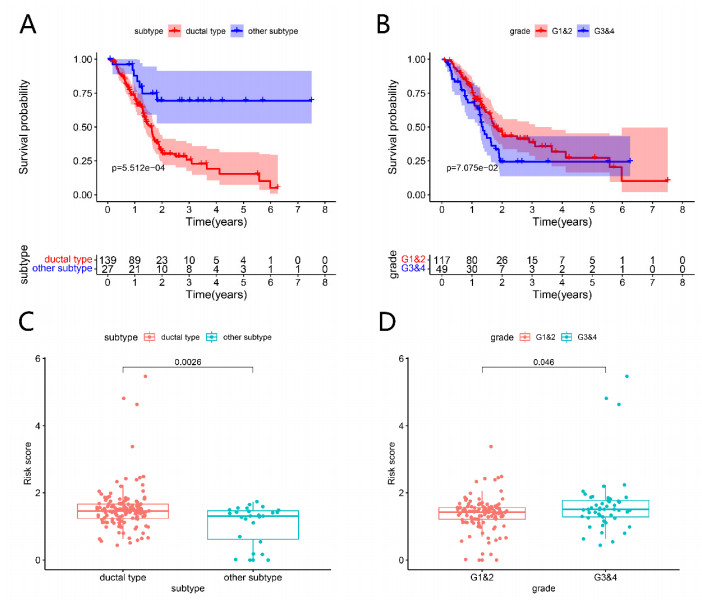1.
Introduction
Pancreatic cancer (PC) is correlated with an inferior outcome with a shallow survival rate [1]. Pancreatic cancer is the seventh leading cause of cancer death in both men and women worldwide [2]. Surgical resection is the primary cure for PC. However, most patients are diagnosed as advanced when metastasis occurs, so only < 20% of PC patients are befitting for surgical resection [3]. Pancreatic cancer progresses rapidly, metastases early, and lacks typical clinical manifestations and sensitive screening methods, which lead to a poor prognosis for PC patients [4]. Adjuvant chemotherapy improves the long-term outcomes of cancer patients. Nowadays, novel biomarkers and neoadjuvant therapies could offer opportunities to improve the outcomes of cancer patients. And more and more researches have suggested that the tumor microenvironment (TME) might be related to the malignant phenotype of tumors [5,6]. PC has a typical fibroproliferative matrix and immune/inflammatory infiltration [7], so it is beneficial to develop effective predictive models to assess patients' prognoses accurately. In recent years, advances in tumor molecular biology have greatly promoted the development of prognostic models based on prognostic-related genes. These molecular markers may help to achieve individualized survival predictions for cancer patients.
The wildly known tumor protein p53 (TP53), a tumor suppressor, is commonly mutated in large human cancers [8]. TP53 is a stress-induced transcription factor, promoting transcriptional activation, apoptosis, cell cycle arrest, senescence, and changes in metabolism [9]. However, once TP53 is mutated, DNA-damaged cells can evade apoptosis and transform into immortal cancer cells. The mutant TP53 protein also loses its function, accumulates in the nucleus, and acquires a new ability to promote tumorigenesis [10]. The mutated TP53 protein accumulated in the nucleus is considered a specific marker of malignant tumors [11]. TP53 is one of the most important tumor suppressors in pancreatic cancer and a promising target for gene therapy. Currently, clinical trials involving the treatment of TP53 mutations are underway [12,13]. In PC, the changes of TP53 are related to tumor invasion and metastasis. Recently, researchers have established some TP53-associated genomic signatures of pancreatic cancer [14,15]. Therefore, it is important to ascertain the part of TP53 in the pathogenesis of PC patients. Also, many types of research have displayed that different anti-tumor immune responses are correlated with the mutation status of TP53 [16,17]. We guessed that the malignant prognosis of PC patients with TP53 mutation might be correlated with the immune system's related changes. We explored the correlation between the TP53 mutation status and the immunophenotype of pancreatic cancer in this study. We screened DEIGs in patients on the bias of different TP53 mutation patterns. Moreover, we have confirmed a TP53-related immune prognostic model (TIPM), which has been proven to be a reliable biomarker for predicting the outcomes of PC patients.
2.
Materials and methods
2.1. Data collection
The RNA sequencing data and the corresponding clinical data of pancreatic cancer samples were deposited for the TCGA database (https://portal.gdc.cancer.gov/, 2021.04.13), the ICGC database (https://dcc.icgc.org/, PACA-AU, 2021.04.13), the GEO website (https://www.ncbi.nlm.nih.gov/geo/, 2021.04.13; GSE78229, n = 49 and GSE28735, n = 42) [18]. And we collected the somatic mutation data of PC samples from the TCGA database. All data related to the study were gathered from TCGA, ICGC, and GEO databases. The acquirement and application of data were conducted following TCGA, ICGC, and GEO publication guidelines and data access policies. We normalized the expression data by log2 transformed. In detecting a duplicate gene, this study uses the average expression value of the gene. The clinical information of PC patients in the five data sets is displayed in Table S1. Figure S1 presents the workflow of this study.
2.2. Gene set enrichment analysis of TP53 mutation
To recognize the latent differences in immunological process between TP53 mutation (TP53mut, n = 81) pancreatic cancer patients and TP53 wild (TP53wt, n = 101) pancreatic cancer patients, we applied the Java program to conduct GSEA (Version: 4.0; https://www.gsea-msigdb.org/gsea/index.jsp) [19] according to the reference gene set "c5.bp.v7.1.symbols.gmt" in TCGA cohort. And we use Perl script (http://strawberryperl.com/) to compute the overall mutation rate of each sample.
2.3. Screening of differentially expressed immune-related genes in the TCGA cohort
We collected 1740 immune-related genes from the TCGA database according to the ImmPort database [20] (http://www.immport.org). We used the R package "Limma" to ascertain DEIGs. The threshold is set as false discovery rate (FDR) < 0.05 and | log2 fold change (FC)| > 1.0.
2.4. Functional analyses of differentially expressed immune-related genes
We used the R packages "clusterProfiler", "org.Hs.eg.db", "enrichplot", and "ggplot2" to carry on the gene ontology (GO) enrichment analysis as well as the gene and Encyclopedia of Genome (KEGG) pathway analysis. We use the Search Tool for the Retrieval of Interaction Genes (STRING, https://www.string-db.org/) [21] to explore the potential interaction between two different genes with a confidence value ≥ 0.4. We use Cytoscape (Version 3.7.1, https://cytoscape.org/) to build the PPI network of DEIGs [22]. Then we use the CytoHubba plug-in and MOCDE plug-in to recognize the hub node and conduct modular analysis [23]. Metascape (http://metascape.org/gp/index) was used for functional analysis of the module genes [24].
2.5. Establishment and validation of immune prognostic features related to TP53 mutation in pancreatic cancer
We used the R package "survival" to carry on univariate Cox analysis, screening the prognostic-related DEIGs in the TCGA cohort. DEIG with P < 0.05 is regarded as a prognostic immune-related gene. Then, we used the R package "glmnet" to further filter prognostic genes with the least absolute shrinkage and selection operator (LASSO) analysis. The LASSO algorithm excludes genes with potentially high correlations with other genes, solving collinearity and overfitting. Finally, a prognostic risk score model was built through multivariate Cox regression. The risk score values of patients were calculated by the expression levels and correlation coefficients of DEIGs. American pancreatic cancer patients were separated into low-risk and high-risk groups based on the value decided by the survival receiver operating characteristic (ROC). The survival and ROC curves were visualized by the R packages "survminer" and "survivalroc". ICGC database (PACA-AU) and GEO database (GSE78229 and GSE28735 data sets), 3 independent cohorts, were used for external validation. Using the R software package "rms", we developed a nomogram according to the multivariate cox regression analysis results.
2.6. Survival analysis and GEPIA analysis
The R packages "survival" and "survminer" were used for survival analysis. Gene Expression Profiling Interactive Analysis (GEPIA, http://gepia.cancer-pku.cn) is an online database [25]. According to a standard processing method, it analyzes the RNA-Seq data from TCGA and the Genotype-Tissue Expression (GTEx).
2.7. The immune landscape in the low- and high-risk prognostic groups
Single-sample gene set enrichment analysis (ssGSEA) can apply genetic markers to each cancer sample by immune cell populations and immune pathways. We use ssGSEA to quantify the infiltration score of 16 immune cells and the activity of 13 immune-related pathways, which is implemented in R package "gsva". [26]
2.8. Prediction of chemotherapeutic response
Chemotherapy is one of the effective methods to treat pancreatic cancer. Therefore, we estimated the clinical response of each pancreatic cancer patient to common chemotherapy drugs according to the Cancer Drug Sensitivity Genomics (GDSC) website [27], investigating whether high-risk and low-risk prognosis group differences in response to chemotherapy. We selected three common chemotherapy drugs, cisplatin, gemcitabine and paclitaxel, to estimate the estimated inhibitory concentration (IC50) value of each pancreatic cancer sample in the TCGA cohort according to the R software package "pRRophetic" (https://github.com/paulgeeleher/pRRophetic20)) [28].
3.
Results
3.1. TP53 mutation related to pancreatic cancer
According to univariate and multivariate prognostic analysis, TP53 mutation was an independent predictor in TCGA pancreatic cancer patients. (Figure 1A, B). As is shown in Figure 1C, the TP53 mutation occurs on chromosome 13, and the most common type of mutation is a missense mutation in TCGA pancreatic cancer patients. Moreover, the outcomes of patients with missense mutations is worse than that of patients with non-missense mutations (Figure 1D).
3.2. Relationship between TP53 mutation and immunophenotype in pancreatic cancer
To further ascertain the role of TP53 mutations in pancreatic cancer, we investigated whether TP53 mutations are correlated with the immunophenotype of pancreatic cancer. First, the RNA sequencing and clinical data from American pancreatic cancer patients were used to screen immune-related biological processes correlated with TP53 status. The GSEA results suggested that the TP53 mut group was concentrated in 842 biological processes, of which 18 were related to immunity (Table S2, immune-related biological processes are marked in red font). Figure S2 showed the first three immune-related biological pathways.
3.3. Identification of differentially expressed immune-related genes between TP53 mut group and TP53 wt group pancreatic cancer patients
According to the analysis results of GSEA, it can be seen that TP53 mutation is closely correlated with the immune-related biological processes in pancreatic cancer. Therefore, we divided pancreatic cancer patients into TP53 mut and TP53 wt groups to screen DEIGs and further ascertain the correlation between TP53 mutations and immunophenotype. We ascertained 26 up-regulated genes and 76 down-regulated genes (FDR < 0.05 and | log2- FC | > 1.0) (Figure 2A, B). Details are in Table S3. GO and KEGG analysis showed that the DEIGs were mainly concentrated in the leukocyte chemotaxis, receptor-ligand activity, cytokine activity, cytokine-cytokine receptor interaction, and T cell receptor signaling pathway (Figure 2C, D). And we built a PPI network and visualized it on Cytoscape. The network comprised three models, including 89 nodes and 298 edges. (Figure 2E, F). Module 1 contains 18 nodes and 61 edges involving cytokine signaling in the immune system, peptidyl-serine phosphorylation, and inflammatory response (Figure S3A). Module 2 contains 10 nodes and 20 edges, involving peptide ligand-binding receptors and inflammatory response (Figure S3B). Module 3 contains 8 nodes and 20 edges, involving peptide hormone biosynthesis and post-translational protein phosphorylation (Figure S3C).
3.4. Construction of immune prognostic features related to TP53 mutation in the TCGA cohort
We carried on a univariate Cox regression analysis in American pancreatic cancer patients, and 13 DEIGs were determined to be notably related to overall survival (P < 0.01, Table S4). LASSO analysis was applied to screen the 13 prognostic DEIGs further. Determine the best lambda value by 10-fold cross-validation (Figure 3A, B). Finally, we used multivariate Cox regression analysis to constract TIPM, including 2 genes. PRLR, which is down-regulated with HR < 1, is considered tumor suppressors, while EREG, up-regulated with HR > 1, is considered oncogenes. The risk score is computed as follows: risk score = (-0.1893 × expression level of PRLR) + (0.0137 × expression level of EREG). Next, we divided pancreatic cancer patients into low- and high-risk prognosis groups using the survival ROC of 1.319 (Figure 3C). Then we draw the risk score distribution, survival status, and survival heat map of PC patients based on the best TIPM signature (Figure 3D). The survival analysis illustrated that compared with the high-risk score group, the low-risk score group had a better outcome (P < 0.001) (Figure 3E). The ROC curve shows that the 1-, 2- and 3-year overall survival (OS) predicted AUC of TIPM are 0.694, 0.678 and 0.717 (Figure 3F). In addition, the risk score in the TP53 mut subgroup was significantly higher than that in the TP53wt subgroup (Figure 3G). Moreover, in Figure S4A–C, the 1-, 2- and 3-year OS predicted AUC of TIPM were higher than the AUC of age, gender, site, subtype, history of prior malignancy, grade, and TMN staging in the TCGA cohort.
3.5. Validation of the TP53-related immune prognostic signature in two external independent pancreatic cancer data sets
We divided the Australian patients in the ICGC cohort into high-risk and low-risk groups according to the same calculation formula and cut-off value as the TCGA. The risk score distribution, survival status, and survival heat map of the Australian PC patients are displayed in Figure 4A. The Kaplan-Meier survival curve suggested that the outcomes of the ICGC cohort was obviously different between the high and low prognosis groups (Figure 4B). Then, among Australian pancreatic cancer patients, the predicted AUC for 1-, 2- and 3-year os of the risk score was 0.764, 0.695 and 0.628 (Figure 4C). Subsequently, we used two external data sets (GSE78229 and GSE28735) to validate the signature predictive performance. The calculation method and the group cut-off value are the same as those in the TCGA. The survival analysis and ROC curve results show that this signature also has good predictive performance in the GEO cohort (Figure 4D, E).
3.6. Independent prognostic value of the TP53-associated immune prognostic signature.
As we all know, a promising prognostic biomarker should be independent of other clinicopathological features to predict patient survival. According to multivariate analysis, the risk score, age, site, and subtype are independent prognostic features that affect outcomes of PC patients (Figure 5A, B; TCGA). At the same time, we carried on univariate and multivariate predictive analysis on the patient information in the ICGC cohort. TIPM is an independent predictor of PC patients in the ICGC cohort, indicating good robustness in independently predicting OS in PC patients (Figure 5C, D; PACA-AU). And Kaplan-Meier curve results showed that regardless of age and site, the os of PC patients in the low-risk group was obviously prolonged (TCGA, p < 0.05, Figure 5E–H). They all show that TIPM has satisfactory independence and applicability in PC patients. We developed a nomogram according to the stepwise Cox regression model to estimate the overall survival rate of pancreatic cancer at 1-, 2- and 3- years. The nomogram parameters include risk score, age, location, and subtype (Figure 5I).
3.7. Prognostic analysis of the model genes and comparison of TIPM with other signatures
The Kaplan-Meier survival analysis displayed that the two model genes were significantly correlated with the prognosis of pancreatic cancer (Figure 6A, B, p < 0.05). And we used GEPIA to verify the expression levels of the two genes. The mRNA expression level of EREG in pancreatic tumor tissues increased obviously, while the mRNA expression level of PRLR decreased (Figure 6C, D). We further compared the prediction performance of the TIPM with three recently published signatures: 5-TP53 signature derived from Zhang's study (hereinafter referred to as ZhangSig) [15], 7-TP53 signature derived from Li's study (hereinafter referred to as LiSig) [14], and 4-mRNA signature derived from Qiu's study (hereinafter referred to as QiuSig) [29] using the same TCGA and PACA-AU cohorts. As shown in (Figure 6E), the AUC at 1 year of OS for the TIPM is 0.690, which is slightly weaker than that of ZhangSig (AUC = 0.740) and LiuSig (AUC = 0.712), and higher than that of QiuSig (AUC = 0.653) in the TCGA cohort. While in the PACA-AU cohort (Figure 6F), the AUC at 1 year of OS for the TIPM is 0.788, which is significantly higher than that of ZhangSig (AUC = 0.690), LiuSig (AUC = 0.768) and QiuSig (AUC = 0.692).
3.8. The immune landscape in the low- and high-risk prognostic groups
We used ssGSEA to determine the differences in the PC immune infiltrates between low-risk and high-risk groups. As shown in Figure 7A, B, mast cells and type II IFN response scored higher in the low-risk group while macrophages scored higher in the high-risk group.
3.9. Chemotherapeutic responses in low- and high-risk prognostic groups
Given that chemotherapy is a standard method for PC treatment, we explored the response of two prognostic groups to cisplatin, gemcitabine, and paclitaxel. We estimated the IC50 value of cisplatin, gemcitabine, and paclitaxel for each pancreatic cancer patient in the TCGA cohort. In Figure 7C–E, the high-risk prognosis group has lower estimated IC50 values for the three chemotherapeutics. The results indicate that the high-risk prognosis group is more effective to the three chemotherapy drugs (cisplatin P = 0.0016, gemcitabine P = 0.01, paclitaxel P = 1e-07).
3.10. The correlation between risk score and pathological characteristics
The prognosis of pancreatic cancer patients with pancreas-adenocarcinoma ductal type is worse than patients with other subtypes (Figure 8A). By comparing the differences in the risk scores of pancreatic cancer patients of different subtypes, the pancreas-adenocarcinoma ductal type has a higher risk score (Figure 8B). Furthermore, with the more advanced grade, the OS of pancreatic cancer patients was significantly reduced (Figure 8C), and the risk score was significantly increased (Figure 8D). These results display that the risk score is essential in predicting the progression of PC patients. And there is no significant correlation between risk score and age and site (Figure S5).
4.
Discussion
Pancreatic cancer is one of the deadliest solid cancers in humans, with a high degree of malignancy and malignant prognosis. Tumor cell infiltration has been confirmed as an indicative factor of the TME in PC patients [6]. Patients with higher levels of tumor-infiltrating lymphocytes and M1 macrophages have a significantly better prognosis [30]. Recent studies have shown that TP53 mutation can be used as an indicator of anti-PD1 therapy for lung cancer and may be related to increased immune checkpoints and the expression of activated T effectors and interferon-γ characteristics [31,32]. However, the mechanism of TP53 mutations in regulating TME of pancreatic cancer remains indistinct. Therefore, it is essential to discuss the effect of TP53 mutation in regulating TME of pancreatic cancer.
We found that TP53 mutation was an independent predictor in pancreatic cancer patients based on univariate and multivariate analysis. Therefore, in clinical, we can use the mutation status of TP53 to predict overall survival in PC patients. Mutant p53 could accelerate the metastasis of pancreatic tumor cells and overcome cell cycle arrest in pancreatic cancer [33]. Our study further confirmed the effect of TP53 mutation in the prognosis of PC patients.
According to the TP53 status, GSEA showed that the GO-BP term of TP53 mut pancreatic cancer patients was obviously correlated with immune-related biological pathways. We then identified 102 DEIGs in pancreatic cancer patients with TP53 mutations. The functional enrichment analysis results showed that DEIGs were correlated with the invasion and metastasis of PC patients. Univariate COX survival analysis indicated that 13 DEIGs were associated with overall survival. Then we established a new type of TIPM (EREG and PRLR) to estimate the outcome of PC patients through Lasso-Cox regression. TIPM identified a high-risk prognostic group with a poor overall survival rate and more significant response potential to PD-L1, cisplatin, gemcitabine, and paclitaxel therapies. TIPM is an independent prognostic predictor of pancreatic cancer.
EREG belongs to the epidermal growth factor (EGF) family, which is up-regulated in PC patients and can promote the growth of pancreatic cancer cells [34]. Epiregulin can stimulate inflammation directly or regulate angiogenesis and vascular remodelling and stimulate cell proliferation [35]. Epiregulin can regulate the differentiation of multiple tissue types. It has been reported that the high expression of EREG seems to be involved in the poor prognosis of some different human malignancies [36,37]. Moreover, the EGFR pathway can be stimulated to promote tumor cell migration, adhesion and metastasis [38], and inhibition of EGFR signaling may reduce the growth and invasion of pancreatic tumor cells [39]. Therefore, the high expression of EREG is closely correlated with the outcome of PC.
PRLR, a type-1 cytokine receptor, has multiple isoforms [40]. Studies have reported the association between PRLR and pancreatic tumors [41,42]. A recent study suggested that PRLR-SF inhibits the expression of G6PD and TKT in the pentose phosphate pathway (PPP) through the NEK9-Hippo pathway to prevent PDAC cell growth [43]. Previous studies and our results indicate that EREG and PRLR may serve as latent biomarkers and therapeutic targets for PC patients.
As a tumor type known to have low immunogenicity and immunosuppressive microenvironment, the immune system plays a vital part in cancer. The level of immune response would affect tumor progression. In the tumor microenvironment (TME), it exists complex interactions between immune cells and cancer cells. The Interactions may lead to different tumor characteristics and multiple immune evasion mechanisms. Therefore, classification and analysis of pancreatic cancer from an immunological perspective is helpful to identify new prognoses and predict biomarkers and can be used for accurate patient stratification and treatment guidance. Our results indicate that mast cells and type II IFN response score higher in the low-risk group, while macrophages scored higher in the high-risk group. Macrophages are considered to be one of the most abundant infiltrating immune cells in the PC matrix. Macrophages can cross-talk with other cancer cells to regulate immune status, thereby creating an immunosuppressive TME [44,45]. Moreover, the high-risk prognosis group is more effective to cisplatin, gemcitabine, and paclitaxel than the low-risk prognosis group, contributing to PC patients' individualized treatment.
Our study has determined the TP53-related immune prognostic characteristics of pancreatic cancer. The results show that risk score, age, site, and subtype are independent prognostic predictors of pancreatic cancer. We constructed a nomogram that combines TIPM with clinicopathological parameters, allowing clinicians to determine the prognosis of individual patients.
It still has some confinements to be explained in our study. This study is a retrospective design. The establishment of our nomogram is according to the TCGA cohort. Therefore, it is essential to use more comprehensive studies with large sample sizes to verify our results, promoting new strategies for precise cancer treatment.
5.
Conclusions
The analysis of pancreatic cancer data from the TCGA cohort manifested that TP53 mutation could be regarded as an independent prognostic factor. We established a TIPM based on EREG and PRLR, closely involving the progression and prognosis of PC patients. TIPM identified the high-risk group with a poor overall survival rate and more significant response potential to cisplatin, gemcitabine, and paclitaxel therapies. Further, we developed a prognostic nomogram that effectively predicts overall survival in PC patients based on TIPM and other clinical characteristics. In summary, TIPM offers an immunological perspective to clarify the mechanism that determines the outcomes of PC patients, and its use can help clinicians make individualized treatment and medical decision-making. But more comprehensive researches with large sample size is necessary to confirm our findings.
Conflict of interest
The authors declare that there are no conflicts of interest.
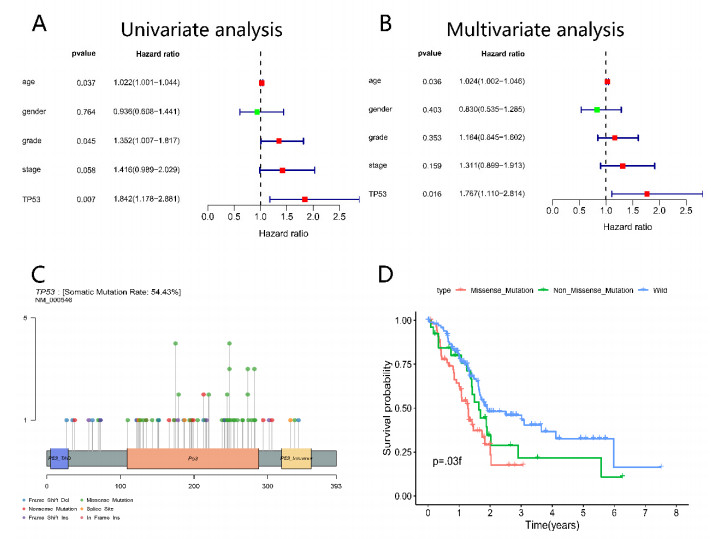









 DownLoad:
DownLoad:
